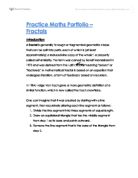A0 = √(3) / 4 l2
A0 = √(3) / 4 12
A0 = 0.4330127019
Perimeter of the snowflake
Is calculated through the perimeter of an equilateral triangle formula:
l0 x N0 = P0
1 * 3 = 3
P0 = 3
Stage 1:
Number of sides:
Is determined by multiplying N0 * 4 or proven through counting the sides.
N1 = 12
Length of a single side
Is determined through dividing l0 by 3.
l1 = 1 / 3
Area of the snowflake
Is calculated through the formula established for the equilateral triangle (as stated on page 2). As well as adding the A0 onto the answer.
A0 = 0.4330127019
A1 = [(3) (1 / 3)2 √(3)] / 4 + A0
A1 = 0.1443375673
A1 = 0.1443375673 + 0.4330127019
A1 = 0.5773502692
Perimeter of the snowflake
Is calculated through the perimeter of an equilateral triangle formula:
l1 * N1 = P1
(1 / 3) * 12 = 4
P1 = 4
Stage 2:
Number of sides:
Is determined by multiplying N1 * 4 or proven through counting the sides.
N2 = 48
Length of a single side
Is determined through dividing l1 by 3.
l2 = 1 / 9
Area of the snowflake
Is calculated through the formula established for the equilateral triangle (as stated on page 2). As well as adding the A1 onto the answer.
A1 = 0.5773502692
A2 = [(3 x 4) (1 / 9)2 √(3) / 4] + A1
A2 = [(12) (1 / 32)2 √(3) / 4] + A1
A2 = 0.0641500299 + A1
A2 = 0.0641500299 + 0.5773502692
A2 = 0.6415002991
Perimeter of the snowflake
Is calculated through the perimeter of an equilateral triangle formula:
l2 * N2 = P2
(1 / 9) * 48 = 5.333333333
P2 = 5.333333333
Stage 3:
Number of sides:
Is determined by multiplying N2 * 4 or proven through counting the sides.
N3 = 192
Length of a single side
Is determined through dividing l2 by 3.
l3 = 1 / 27
Area of the snowflake
Is calculated through the formula established for the equilateral triangle (as stated on page 2). As well as adding the A2 onto the answer.
A2 = 0.6415002991
A3 = [(3 * 4 * 4) (1 / 27)2 √(3) / 4] + A2
A3 = [(48) (1 / 33)2 √(3) / 4] + A2
A3 = 0.0285111244 + A2
A3 = 0.0285111244 + 0.6415002991
A3 = 0.6700114235
Perimeter of the snowflake
is calculated through the following formula:
l3 * N3 = P3
(1 / 27) * 192 =
P3 = 7.111111111
3. For each of the three graphs above develop a statement in terms if the four sets of values shown in this graph. Explain how you arrived at your generalizations. Verify that your generalizations apply consistently to the sets of values produced above.
The number of sides:
192 / 48 = 4
The number of sides is determined by multiplying the Nn-1 (the stage before) by 4.
Nn-1 * 4 = Nn
The length of a single side:
(1 / 9) / (1 / 3) = 0.333333333
The length of a single side is determined by dividing the l-1 (the stage before) by 3.
ln-1 / 3 = ln2 √(3) / 4
The length of the perimeter:
7.1111111111 / 5.333333333 = 1.333333333
Suggests the perimeter increases by (4/3) by every iteration.
Pn = Nn * ln * (4/3)
Pn = 12 * (1/3)
Pn = 4 (the length of a single side)
P = 4 * (4/3)
P = 5.333333333 (the next stage)
Thus we can determine that through using (4/3)n the perimeter of any internal stage can be found.
Pn = 3 * (4/3)n
The area of the snowflake:
A3 = [(3 * 4 * 4) (1 / 27)2 √(3) / 4] + A2
A3 = [(48) (1 / 33)2 √(3) / 4] + A2
A3 = 0.0285111244 + A2
A3 = 0.0285111244 + 0.6415002991
Through this equation it can be reduced to the following formula.
An = Nn-1 * ln2 * √(3) / 4 + An-1
4. Investigate what happens at n = 4. Use your conjectures from part 3 to obtain values for N4 , l4 , P4 , A4 . Now draw a large diagram of one side (i.e. one side of the original triangle that has been transformed) of the fractal at Stage 4 and clearly verify your predictions.
Stage 4:
The number of sides:
Nn-1 * 4 = Nn
N4-1 * 4 = N4
N3 * 4 = 768
N4 = 768
The length of a single side:
ln-1 / 3 = ln
l4-1 / 3 = l4
l3 / 3 = l4
(1 / 27) / 3 = 0.012345679 or 1 / 81
l4 = 0.012345679 or 1 / 81
The length of the perimeter:
Pn = 3 * (4/3)n
P4 = 3 * (4/3)4
P4 = 9.481481481
Proven by:
N4 * l4 = P4
768 * (1 / 81) = 9.481481481
P4 = 9.481481481
The area of the snowflake:
An = Nn-1 * ln2 * √(3) / 4 + An-1
A4 = 192 * (1/81)2 * √(3) / 4 + An-1
A4 = 0.0126716108 + 0.6700114235
A4 = 0.6826830343
5. Calculate values for N6 , l6 , P6 and A6 . You need not verify these answers.
The number of sides:
Nn-1 * 4 = Nn
N5 * 4 = N6
3072 * 4 = N6
N6 = 12288
The length of a single side:
ln-1 / 3 = ln
l5 / 3 = l6
(1 / 243) / 3 = 0.0013717421 or 1 / 729
l6 = 0.0013717421 or 1 / 729
The length of the perimeter:
Pn = 3 * (4/3)n
P6 = 3 * (4/3)6
P6 = 16.85596708
The area of the snowflake:
An = Nn-1 * ln2 * √(3) / 4 + An-1
A6 = 3072 * (1 / 729)2 * √(3) / 4 + A5
A6 = 0.0025030342 + 0.6883148613
A6 = 0.6908178955
6. Write down successive values of An , in terms of A0- .What pattern occurs?
Total Area:
A0 = 0.4330127019
A1 = 0.5773502692
A2 = 0.6415002991
A3 = 0.6700114235
A4 = 0.6826830343
A5 = 0.6883148613
A6 = 0.6908178955
Triangle areas added at each internal:
A1 = 0.1443375673
A2 = 0.0641500299
A3 = 0.0285111244
A4 = 0.0126716108
A5 = 0.005631827
A6 = 0.0025030342
The pattern that emerges is that through each stage the area increases in size, however to a lesser extent. This is because during the first stages the addition of triangles would result in a large amount of area being added to the initial triangle. However as the stages continued, at around the second stage the triangle began to gain less and less area with each iteration. This statement is supported by the triangle areas, where they would decrease throughout each iteration.
7. Explain what happens to the perimeter and area, as n gets very large. What conclusions can you make about the area as n → infinity? Comment on your results.
As n gets very large the perimeter continues growing exponentially. There is not limit to the number that n can reach due to the calculation formula having no boundary. Eventually the snowflake would be made up of only sharp corners with no smooth lines connecting them, however this would not limit the infinite series because as long as the perimeter of the snowflake is connected the fractal will maintain its shape.
The area of the snowflake would also follow this trend. Although as n reached infinity the increase in area would become microscopic and possibly unmeasurable. However theoretically speaking the area would still increase.






